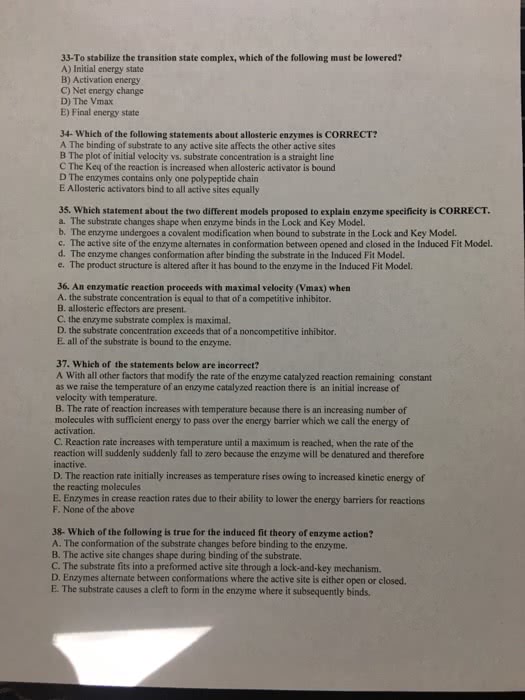1. C6H12O6 + 6O2 Ã 6CO2 + 6H2O Glucose is being _____ to _____ and oxygen is being _____ to _____. a. oxidized; carbon dioxide; reduced; water b. oxidized; water; reduced; carbon dioxide Incorrect c. reduced; water; oxidized; carbon dioxide d. reduced; carbon dioxide; oxidized; water
2. Which of the following stages in the breakdown of the piece of toast you had for breakfast generates the most ATP? a. the citric acid cycle Incorrect b. glycolysis c. the digestion of starch to glucose d. oxidative phosphorylation
3. Which of the following is a catabolic pathway? a. gluconeogenesis b. production of starch Incorrect c. glycolysis d. production of glycogen
4. Per molecule, the oxidation of a fatty acid results in _____ energy storage than the oxidation of glucose. a. the same b. less Incorrect c. more d. None of the above; fatty acids cannot be oxidized.
5. Of the eight reactions in the citric acid cycle, how many are oxidation-reduction reactions? a. one b. two c. three d. four e. five
6. The process of glycolysis transfers the energy in sugar molecules into the stored energy of activated carriers such as ATP and NADH. Which statement is true about glycolysis? a. Only eukaryotic organisms do glycolysis. b. The ten reactions of glycolysis are identical in all eukaryotic cells, but are different in prokaryotic cells due to their diverse metabolic strategies. Incorrect c. The ten reactions of glycolysis are identical in almost all living organisms on the planet. d. There are many ways to oxidize glucose and transfer energy into activated carriers; the diversity of organisms on the planet is reflected in the diversity of their mechanisms of glycolysis.
7. Referring to the sentence completed in #13 above, the purpose of the latter reaction (in active muscle cells) is to _____. a. accumulate lactic acid in the cell, which provides additional energy for the production of ATP Incorrect b. slow down glycolysis until oxygen becomes available again c. accelerate the Krebs cycle, which will restore the oxygen supply d. regenerate NAD+ so that glycolysis can continue in the absence of oxygen
8. What are the products of the citric acid cycle? a. carbon dioxide, NADH, FADH2 and GTP b. carbon dioxide, NAD+, FAD and GTP c. NADH, FADH2, and acetyl CoA Incorrect d. carbon dioxide and water
9. Which statement is true about enzymes? a. Enzymes catalyze chemical reactions because they make inherently endergonic reactions exergonic. b. Each enzyme in a cell can catalyze many different chemical reactions involving chemically different substrates. Incorrect c. Enzymes can only catalyze reactions in one direction. d. After catalyzing a reaction, an enzyme is permanently altered and can no longer bind substrate. e. None of the above is true. 1
10. âG measures the change in free energy in a system as it converts reactant (Y) into product (X). When [X] = [Y], âG is equal to _____. a. RT b. ÎG° + RT c. ÎG° d. ln [X]/[Y]
11. The âG° for the hydrolysis of ATP is -7.3 kcal/mol. What conditions in the cell would lead to a âG for ATP hydrolysis of -11 kcal/mol? a. An increase in the ATP/ADP ratio b. An increase in anabolic activity in the cell c. Transport of ATP out of the compartment where the reaction is occurring Incorrect d. A decrease in the ATP/ADP ratio
12. In the first reaction of glycolysis, a phosphate transferred from ATP to a glucose molecule to produce glucose-6-phosphate and ADP. Under conditions existing in the cell, the free energy change for this reaction is -8.0 kcal/mole. Which of the following statements is true? Recall that the âG° for the hydrolysis of ATP is -7.3 kcal/mol. a. Glucose concentrations in the cell are always low, making this reaction more favorable than would be expected. b. This reaction is less favorable than would be expected, given the âG° of ATP hydrolysis. c. Glucose-6-P concentrations in the cell are very low relative to glucose concentrations, making the reaction more favorable than would be expected. d. The âG° for the addition of a phosphate to glucose must be -0.7 kcal/mole.
13. Protein E can bind to two different proteins, S and I. The binding reactions are described by the following equations and values: E + S --> ES Keq for ES = 10 E + I> EI Keq for EI = 2 Given the equilibrium constant values, which one of the following statements is true? a. When S is present in excess, no I molecules will bind to E. b. E binds I more tightly than S. c. The binding energy of the ES interaction is greater than that of the EI interaction. d. Changing an amino acid on the binding surface of I from a basic amino acid to an acidic one will probably make the free energy of association with E more negative.


